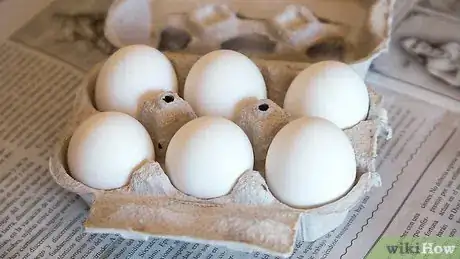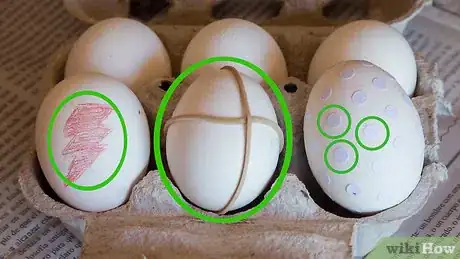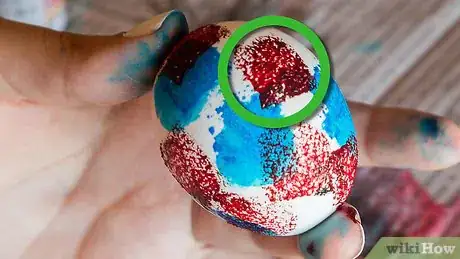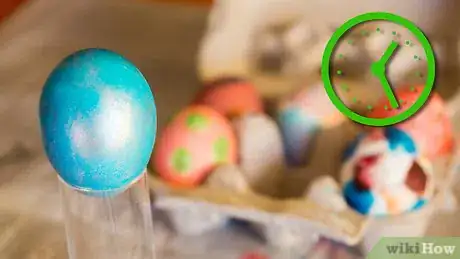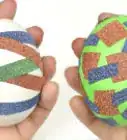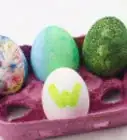wikiHow is a “wiki,” similar to Wikipedia, which means that many of our articles are co-written by multiple authors. To create this article, 66 people, some anonymous, worked to edit and improve it over time.
This article has been viewed 952,183 times.
Learn more...
Coloring hard boiled eggs is an Easter tradition. The fun part is, there are so many ways to do it! You can do single coloured eggs, but an added touch never hurt anyone. You can eat these eggs, give them as gifts, or use them for decoration.
Steps
-
1Organise the supplies needed. There are a few things you need to do before commencing:
- Buy a half dozen to a dozen eggs at the grocery store, or collect them fresh from your hens.
- Hard boil the eggs. Do this by placing the eggs into a saucepan with a pinch of salt and covering with water. Bring to the boil and then reduce to a simmer. Simmer for at least ten (10) minutes and then lift the eggs out carefully with a spoon or tongs. Place them under cold running water until they are cool enough to handle, at least a minute, and cool completely on a rack in the refrigerator before using.[1]
- Buy an egg decorating kit! These usually consist of several dye pellets, colour coded cups, a special egg spoon, and, of course, directions to make the dye. Or buy a set of little bottles of food colouring, which you can use for all kinds of projects such as tie-dyed cake.
-
2Follow the directions on the dye packaging carefully and make the dye. In most cases, you drop the pellets into water or vinegar (about 1 tablespoon of vinegar). (Liquid food colouring usually requires vinegar). Make sure to have both nearby. You can use a glass, cup, or a bowl to pour the water into, just make sure the container has enough space for the egg. A disposable plastic cup (suitable for hot liquids, if you're using them) would be perfect because staining it won't matter and it may cushion eggs dropped in a little.
- Set the containers of dye in a row. Place the hard boiled eggs in one spot for easy access. It's also a good idea to set up the work surface by covering it with newspaper (you can then rest the eggs on this as you add more dye effects, and it will also catch dye drips.) And add an egg carton or a wire rack for drying the eggs on after they are dyed.
Advertisement -
3Decorate each egg before dyeing if you intend on adding features. If wished, you can draw on the eggs with crayon, or place rubber bands or dot stickers on the egg. Covering parts of the egg with tape, stickers, crayon wax from drawing, or rubber bands will result in the covered parts of the egg not being coated in the dye you are about to dip the egg in but will create their own cool effects.
- You could dye an egg a light colour, mask off parts, and dye the rest a darker colour.
- Naturally, you can add decorative effects after dyeing as well. It's really up to you and a good way to find out what you prefer is to try decorating both before and after dyeing the eggs.
-
4Set the egg on the egg spoon, and lower it into the desired colour. You can either lower it in partway to dye only a certain segment of the egg, or lower it in all the way. Leave the egg in for at least 3 minutes before considering removing it.[2]
- The egg will soak up more colour the longer you wait, so if the colour isn't what you want just yet, leave it a little longer.
-
5Place the removed egg onto a work surface that has been covered in newspaper. At this point, you can place a different drop of colouring on the egg for added colour effects and then blow through a straw to disperse the drop of dye across the egg. This will make interesting new patterns. You can also use a paintbrush to move the dye around if you like.
- To make an especially beautiful egg, repeat these steps as much as desired. Continuous re-dipping of the eggs will result in colours mixing together, multiple layers of patterns (some coloured), and varicolored stripes. You can take off the bands and stickers in between rinses or not; experiment with different methods, as explained in the next sections.
-
6Leave the eggs to dry in the egg carton or, better yet, a wire rack which will minimise the marred contact points. Place each egg there as done, and get on with the next egg until you've finished with them all.
Marbled Eggs
-
1Prepare the egg dye according to the package or make your own using natural food colourings. If you plan to eat the eggs, make sure to use food-grade dyes.
- Add a teaspoon of vegetable oil to each container of dye. Note that if you want to dye some eggs normally or give them a base colour before marbling, do that first. Once the oil is in the dye, you can't go back! Experiment by adding a bit more oil to the dyes; different amounts create different amounts of marbling.
- Better yet, float droplets of a concentrated food coloring-vinegar (for colorfastness) mixture on a bed of shaving cream or float droplets of an oil-based immiscible food coloring on water, rake the color into a loose pattern, and dip the egg briefly to marble it as one would marble paper.[3] You may need to dip one end or side of the egg at a time. A pair of tongs with loop-ended jaws would hold the egg securely and mask very little of its surface. If you use shaving cream, let the egg dry before rubbing off the excess foam. With either method, be prepared for the possibility that the colour may stick to you or what you're wearing better than the egg, even after it's dry.
- Add a teaspoon of vegetable oil to each container of dye. Note that if you want to dye some eggs normally or give them a base colour before marbling, do that first. Once the oil is in the dye, you can't go back! Experiment by adding a bit more oil to the dyes; different amounts create different amounts of marbling.
-
2Dip quickly. Using a spoon or the dipper that comes with a kit, lower the egg completely into the dye and remove it quickly. Because oil and water don't mix, you'll get colour on some parts of the egg, and none on others, creating a marbled effect. Keep dipping to get a brighter color.
-
3Dry the eggs on a paper towel. Lightly pat the just-dipped eggs with a paper towel, or the colour may become muddy. If you want to dip them in another colour, wait until they're completely dry first.
-
4Add some shine. Moisten a paper towel with vegetable oil and lightly wipe down the finished eggs with it to add a nice shine.
-
5Refrigerate. Refrigerate the eggs until you're ready to display them.
- Wow everyone with your masterpiece!
Sponge Dip
-
1Put five drops of food coloring in a cup and add a few drops of water.
-
2Dip a sponge into the cup and press onto egg.
-
3Let it dry.
-
4Do the same with a different color.
-
5Continue using other sponges with different colors, but let dry in between.
Polka Dot Eggs
-
1Stick dot stickers on the egg.
-
2Color it with any color or colors.
-
3Let the egg dry completely.
-
4Carefully peel off the stickers.
-
5Alternatively, paint the dots onto each egg as preferred.
Glitter Egg
-
1Dye the egg the desired color or colors.
- Add white vinegar to the dye for a deeper color.
-
2Cover with glitter paint. Or, add glitter to the dye beforehand (this is easier).
-
3Let dry. You now have a very glam egg for Easter.
-
4Finished. The glitter egg is now ready for displaying.
Community Q&A
-
QuestionWhat happens if I don't have food coloring? Can I use paint?
 Community AnswerYes, you can use either spray paint or watercolor. They both work. If you try doing it more delicately, then it will be more reliable with the eggs if they are real eggs.
Community AnswerYes, you can use either spray paint or watercolor. They both work. If you try doing it more delicately, then it will be more reliable with the eggs if they are real eggs. -
QuestionCan I use brown eggs when dying eggs for Easter?
 Community AnswerYou can; however, the color will be more saturated and darker (some prefer that look).
Community AnswerYou can; however, the color will be more saturated and darker (some prefer that look). -
QuestionIs it alright to dye eggs year around?
 Community AnswerYes. It's always okay to dye eggs.
Community AnswerYes. It's always okay to dye eggs.
Warnings
- The glitter egg is for decoration only, so don't eat it.⧼thumbs_response⧽
- Peel the eggs before eating, and don't eat the shells!⧼thumbs_response⧽
- Only eat the eggs if you have kept them refrigerated and you have used non-toxic, food-grade dyes and decorations. Egg shells are very porous!⧼thumbs_response⧽
Things You'll Need
-
To Set Up:
- Hard boiled eggs
- Egg decorating kit
- Egg carton(s)
- Vinegar
- Water
- Measuring cup(s)
-
For the "Fancy" Eggs:
- Crayons
- Rubber bands
- Dot stickers
- Sponges
- Glitter paint
- Vegetable oil
References
- ↑ Fiona Hammond, Easter Cooking and Other Fun Stuff for Kids, p. 24, (2011), ISBN 978-1-74248-731-1
- ↑ Fiona Hammond, Easter Cooking and Other Fun Stuff for Kids, p. 24, (2011), ISBN 978-1-74248-731-1
- ↑ http://www.frugalfamilyfunblog.com/2009/05/5-friday-paper-marbling-this-is-awesome.html
- ↑ Fiona Hammond, Easter Cooking and Other Fun Stuff for Kids, p. 25, (2011), ISBN 978-1-74248-731-1
- ↑ Fiona Hammond, Easter Cooking and Other Fun Stuff for Kids, p. 24, (2011), ISBN 978-1-74248-731-1
- Fun & Games / Easter / Egg Decorating, http://www.meddybemps.com/easter/eggdeco.html – research source
About This Article
To dye eggs for Easter, start by hard boiling the eggs and letting them cool completely. Next, create multiple containers of the water or vinegar dye mixture according to your dye's instructions, making each container a different color. Then, place an egg on a spoon and lower it gently into the desired color. Leave the egg in the dye mixture for at least 3 minutes. The longer it soaks, the more vibrant the results will be! Finally, remove the egg and place it back in the original carton or on a covered surface to dry. For tips on creating cool effects and designs, read on!
